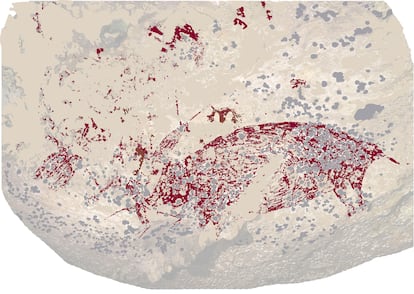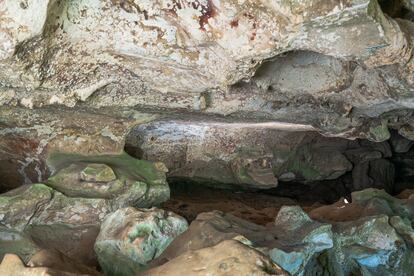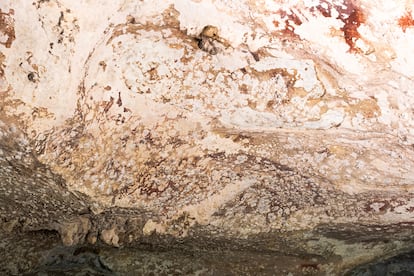The first work of art was painted more than 50,000 years ago in Indonesia
The discovery of a cave hunting scene indicates that rock art dates back even earlier than previously thought

A drawing of humanoid figures hunting a wild pig is the oldest work of art reported to date: it was painted 51,200 years ago in a cave on the island of Sulawesi, in Indonesia. The discovery, made by an international team of scientists and published on Wednesday in the journal Nature, suggests that scenes of people and animals in art date back even earlier than previously thought.
Prehistoric rock art extends our understanding of early human cultures, but reliably dating it is a difficult task. In 2018, archaeologist Maxime Aubert and his colleagues found the oldest figurative painting in a corner of the island of Borneo in Indonesia. The painting — of an animal being skewered by a spear — dated back 40,000 years. Months later, in 2019, an even older painting was discovered: a depiction of two wild boars, four dwarf buffaloes and eight humanoid figures was discovered on the island of Sulawesi. It was estimated to be 4,000 years older.
Today, the team has achieved a much more precise date using laser-ablation U-series imaging. Thanks to this technique, the researchers have discovered that the paintings are even older. According to the study, the painting on the island of Sulawesi, which was discovered in 2019, is at least 48,000 years old, meaning figurative art appeared at least 5,700 years earlier than first thought. And the one from 2018 is even older. “For the first time, we have rock art reliably dated beyond 50,000 years,” says Aubert.
Human’s ability to tell stories
Regardless of whether the art depicts a hunt or another event, it is probably the oldest story told in pictures. Scientists believe the artists were Homo sapiens, our own species, who arrived on these Southeast Asian islands. The art is not simple, but rather “quite advanced,” according to Aubert, “and demonstrates the mental ability of the people of that time.”
The ability to tell stories is a characteristic that has been considered fundamental to human’s cultural evolution. The oldest evidence of it is engraved ocher nodules found in South Africa, which date back 100,000 years. The next evidence is the latest discovery: the cave painting from 50,000 years ago. “There is nothing more in the middle than what we are currently aware of,” says Aubert, although he is confident of making future discoveries. “We will probably find older rock art.”
With the first discoveries in Indonesia, it was proven that figurative art did not originate in Europe. But cave art later developed and evolved in more or less the same way in other places around the world. In Europe, the oldest depictions of animals are found in the Chauvet cave in France, and date back more than 30,000 years. Diego Gárate, a professor of prehistory at the University of Cantabria in Spain, who did not participate in the study, finds it “curious” that hunting scenes have been represented for millennia, with similar imagery used throughout the world. Questions remain as to whether the inhabitants of Asia and Europe invented symbolic art on their own, or whether the humans who conquered the world from Africa were already artists who told stories with images.




“It is a paradigm shift, we move from Eurocentrism to thinking about other possibilities,” says Gárate, regarding the Indonesian works found in recent years. But he points out: “It is not a competition of which is the oldest. The next goal is to know who the people who did these works were, since we don’t know much about them.”
The new technique for determining the age of works, called laser-ablation U-series imaging, uses a laser to analyze samples in minute detail and obtain better calculations. “In short, it is more precise and more efficient,” explains Aubert. This is a significant advance in rock art dating, which can be used in the future, as it requires much smaller samples and reduces damage to the works. The method can be applied to other paintings and possibly in other geological contexts such as sandstone.
The more knowledge advances, the more mysterious the origins of humans and their artistic manifestations become, since at any moment a new discovery can dismantle all previous theories. For this reason, Aubert highlights the importance of continuing to explore and preserve prehistoric treasures: “Humans have probably been telling stories for much more than 51,200 years.”
Sign up for our weekly newsletter to get more English-language news coverage from EL PAÍS USA Edition
Tu suscripción se está usando en otro dispositivo
¿Quieres añadir otro usuario a tu suscripción?
Si continúas leyendo en este dispositivo, no se podrá leer en el otro.
FlechaTu suscripción se está usando en otro dispositivo y solo puedes acceder a EL PAÍS desde un dispositivo a la vez.
Si quieres compartir tu cuenta, cambia tu suscripción a la modalidad Premium, así podrás añadir otro usuario. Cada uno accederá con su propia cuenta de email, lo que os permitirá personalizar vuestra experiencia en EL PAÍS.
¿Tienes una suscripción de empresa? Accede aquí para contratar más cuentas.
En el caso de no saber quién está usando tu cuenta, te recomendamos cambiar tu contraseña aquí.
Si decides continuar compartiendo tu cuenta, este mensaje se mostrará en tu dispositivo y en el de la otra persona que está usando tu cuenta de forma indefinida, afectando a tu experiencia de lectura. Puedes consultar aquí los términos y condiciones de la suscripción digital.
More information
Archived In
Últimas noticias
There is as much life left to discover on planet Earth as that which is already known
Dozens presumed dead, around 100 injured in fire at Swiss Alps bar during New Year’s celebration
Is porn for women different from conventional porn? We spoke to those who make it
Cartagena de Indias is sinking: What can the city do to mitigate it?
Most viewed
- Reinhard Genzel, Nobel laureate in physics: ‘One-minute videos will never give you the truth’
- David King, chemist: ‘There are scientists studying how to cool the planet; nobody should stop these experiments from happening’
- Oona Chaplin: ‘I told James Cameron that I was living in a treehouse and starting a permaculture project with a friend’
- Sinaloa Cartel war is taking its toll on Los Chapitos
- The Interoceanic Train, the Mexican alternative to the Panama Canal










































